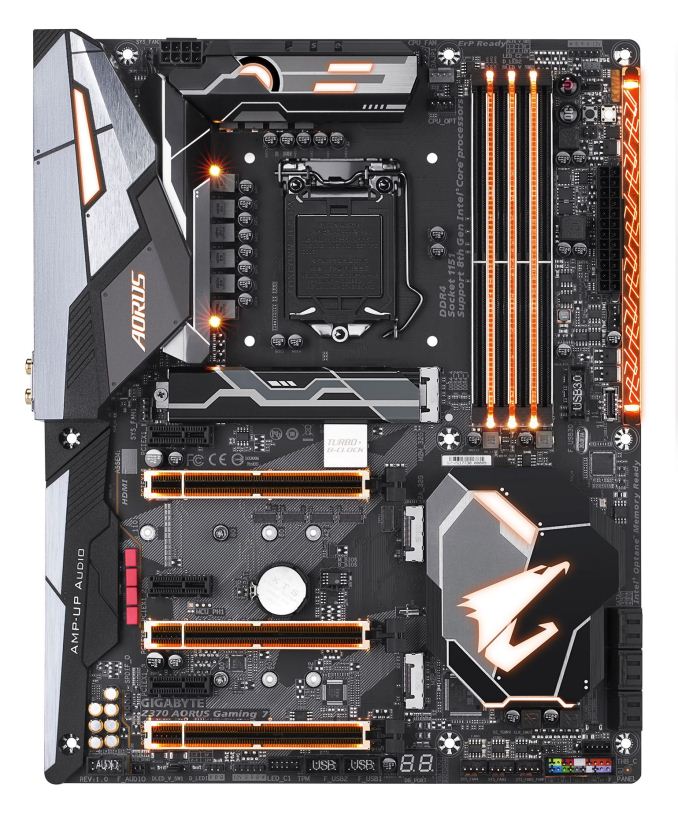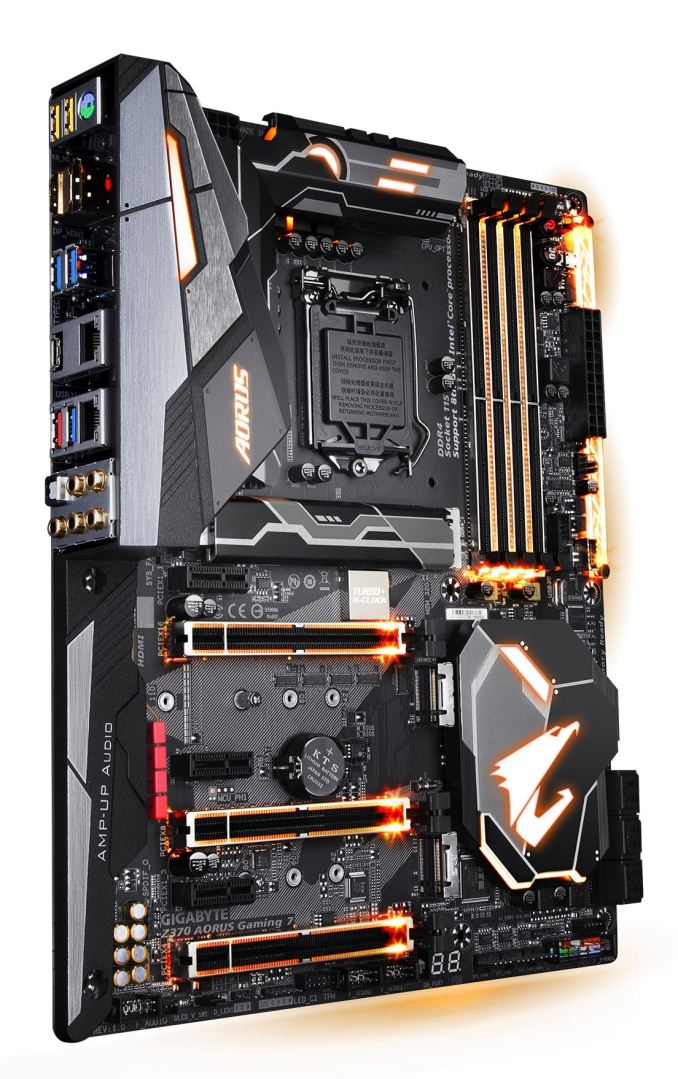Analyzing Z370 for Intel's 8th Generation Coffee Lake: A Quick Look at 50+ Motherboards
by Ian Cutress, Anton Shilov, Joe Shields & Gavin Bonshor on October 20, 2017 2:00 PM ESTGIGABYTE AORUS is starting off its entrance into the Z370 chipset with a total of nine offerings. The 'entry level' Ultra Durable lineup has three boards: the Z370XP SLI, HD3P, and HD3. The AORUS Gaming lineup has the other six boards, offering more features and glamor than the UD boards. From the flagship down there is the Gaming 7, Gaming 5, Ultra Gaming, Gaming 3, Gaming K3, and Gaming Wi-Fi. Each board will offer slightly features from a different VRM section, the number of M.2 connections, USB, networking, audio codecs, and more.
GIGABYTE Z370 Gaming 7
The AORUS Gaming 7 looks to be the brightest (literally) board of the bunch with RGB LEDs found in several places on the board: the IO cover, the VRM heatsink, by the VRMs on the board, between the DIMM slots, on the PCIe slots, the PCH heatsink, and finally, an aesthetic strip on the right side by the 24-pin ATX connector.
All of the full-length PCIe slots have steel reinforcement to prevent slot damage against heavy video cards. The Gaming 7 is the only board in the lineup to add power/reset and overclocking buttons on the PCB which are located in the upper right-hand corner. The Gaming 7 uses different chokes for the VRM from Coiltronics (FP 1007) - from the pictures provided, we are unable to tell if the MOSFETs or controller is different to the Gaming 5. For more BCLK range and flexibility for overclocking, there is a BCLK generator under the EMI shield between the top M.2 and PCIe slots.
The Gaming 7 uses of four reinforced DIMM slots with RGB LEDs in between. capable of up to 64GB of system memory. The supported memory speeds for the Gaming 7 (and Gaming 5) are the highest in the GIGABYTE lineup at DDR4-4133. The other boards will top out at DDR4-4000 by comparison. The PCIe slot locations allow for triple wide video cards to be used in a Dual GPU setup and are wired in an x16/x8/x4 configuration with the last slot powered by the chipset, meaning two-way SLI and three-way Crossfire are supported. PCIe x1 slots are located above the first, second, and last full-length PCIe slots and are fed from the chipset. The last PCIe slot shares bandwidth with the M2P_32G and will operate at up to 2x mode when using a PCIe SSD in that specific slot.
For SATA storage, we will see a pretty familiar theme across the entire lineup as each board will have six SATA ports. In the case of the Gaming 7, they are located to the right of the chipset heatsink and set at a right angle to the board. The three M.2 slots can be found just above the first PCIe x1 slot, below the first full-length slot, as well as the second. The top M.2 slot comes with a heatsink and will fit up to a 110mm device, while the other two slots support up to 80mm drives and do not come with a heatsink.
For users that connect chassis and system fans to the board directly, the Gaming 7 has a total of eight fan headers: the CPU fan and CPU_Opt are located by the socket between the DIMM slots and the VRM heatsink; Across the bottom are three system fan headers with a fourth hiding at the end of the top M.2 slot behind the rear I/O audio; the eighth fan header is located in the top right corner of the board. All headers are hybrid and can be controlled by PWM or voltage using the RGB Fusion software.
Audio is driven by the Realtek ALC1220 codec and uses an ESS Sabre DAC, Nichicon caps, and WIMA audio caps in an effort to improve headphone output. The Gaming 7 has dual NICs, using the Rivet Networks Killer E2500 controller alongside the Intel I219V. There is no Wi-Fi, which is perhaps an interesting omission on a flagship board - however the Gaming 5 does have WiFi. Thunderbolt 3 connectivity is maintained on the Gaming 7 with the header located in the bottom right-hand corner above the front panel headers.
USB support is a bit different here than the other GIGABYTE boards. The Gaming 7 has USB3.1 (10 Gbps) Type-C and Type-A headers on the rear I/O but also add a Type-C header for the front. USB3.1 (5 Gbps) shows a header for the front and five ports on the rear. The rear I/O is a bit more sparse without Wi-Fi, but it still includes Displayport and HDMI outputs for video, the two NICs, five USB 5 Gbps Type-A ports, and the two USB 3.1 (10 Gbps) ports (Type-A and Type-C).
The Gaming 7 comes with everything most users need including a lot of RGB LEDs and adds features such as a reinforced third PCIe slot, a Killer E2500 NIC, onboard Power/Reset/OC buttons, and improved headphone audio. About the only thing missing is Wi-Fi which could also be added via an add-in card.
| GIGABYTE Z370 AORUS Gaming 7 | |
| Warranty Period | 3 Years |
| Product Page | Link |
| Price | Amazon US |
| Size | ATX |
| CPU Interface | LGA1151 |
| Chipset | Intel Z370 Express |
| Memory Slots (DDR4) | Four DDR4 Supporting 64GB Dual Channel Support DDR4 4133+ Support for ECC UDIMM (operates in non-ECC mode) |
| Network Connectivity | 1 x Rivet Networks Killer E2500 LAN 1 x Intel GbE LAN |
| Onboard Audio | Realtek ALC1220 |
| PCIe Slots for Graphics (from CPU) | 1 x PCIe 3.0 x16 slots @ x16 or x8 1 x PCIe 3.0 x16 slots @ x8 |
| PCIe Slots for Other (from Chipset) | 1 x PCIe 3.0 x16 slots @ x4 3 x PCIe 3.0 x1 slots @ x1 |
| Onboard SATA | 6 x Supporting RAID 0/1/5/10 |
| Onboard SATA Express | None |
| Onboard M.2 | 3 x PCIe 3.0 x4 - NVMe or SATA |
| Onboard U.2 | None |
| USB 3.1 (10 Gbps) | 1 x Type-C (ASMedia) 1 x Type-A (ASMedia) 1 x Type-C (ASMedia - through internal header) |
| USB 3.1 (5 Gbps) aka USB 3.0 |
5 x Back Panel 1 x Header |
| USB 2.0 | 2 x Headers |
| Power Connectors | 1 x 24-pin EATX 1 x 8-pin ATX 12V 1 x 4-pin ATX 12V |
| Fan Headers | 1 x CPU 1 x Watercooling CPU 5 x System Fan headers 1 x 3A System Fan/ Water Pump header |
| IO Panel | 1 x PS.2 keyboard/mouse port 1 x DisplayPort 1 x HDMI Port 5 x USB 3.1 ports 1 x USB 3.1 Type-C 1 x USB 3.1 Type-A 2 x RJ-45 LAN Port 1 x Optical S/PDIF out 5 x Audio Jacks |













83 Comments
View All Comments
EricZBA - Friday, October 20, 2017 - link
The Asus Strix Z370-G mATX may be up on Amazon's website, but it has been Out of Stock ever since the page went up with no shipping date in sight. NewEgg Canada has it out of stock and NewEgg's US website doesn't even have a page for it. To call it available is inaccurate.Rubinhood - Friday, October 20, 2017 - link
Coffee Lake & related hardware is the new Duke Nukem Forever :)xchaotic - Monday, October 23, 2017 - link
Well, I am typing this on Asus Strix Z370 I + i5 8400 PC so not entirely vaporware. People may be whining but it seems that Intel can't keep up with the demand...piiman - Thursday, October 26, 2017 - link
got an 8600k today at Newegg. They still have stock after 4 hours so it looks like they may be starting to get large shipments. I7 is still out of stock thoughimaheadcase - Saturday, October 21, 2017 - link
Amazon is different than newegg, if it says Out of Stock, if you order it it will ship when it comes in stock. Sometimes it will be same day even or next day. Amazon will only show "This item is not available" if completely out of stock for foreseeable future. They do this because it stops items from completely selling out right away so supply can be steady.Morawka - Saturday, October 21, 2017 - link
I have found that Asus treats USA customers like a red headed step child. They will send units to the UK, australia, and all of Europe before they will send 1 single board to the USA.Some advice: Start looking at Overclockers.UK and have it imported to the USA.. The $30 DHL International shipping is faster than USPS Priority Mail or UPS International Express Saver. No VAT tax either.
This is what i had to do to get a Rampage VI Extreme. Newegg hasn't gotten a R6E in stock for 2 months after the initial release batch.
SpartanJet - Sunday, October 22, 2017 - link
Does Asus USA cover warranty issues then since you bought it from UK?Xeres14 - Monday, October 23, 2017 - link
Yeah I've been waiting on the Asus z370-g. I can't find an i7-8700k right now either so it's all right. Hopefully I'll be able to get both before Christmas (along with the rest of the upgrade).stuffwhy - Friday, October 20, 2017 - link
This is so great. I find it increasingly difficult to find the right mainboard and this type of posting consolidates a lot of research time.SanX - Sunday, October 22, 2017 - link
There are no "right" mobo here. Right future proof and super fast mobo has to be a dual-processor at least. Dual-SLI for example offers benefits for speed but in many cases the dual-chip is doing the same in simulations.